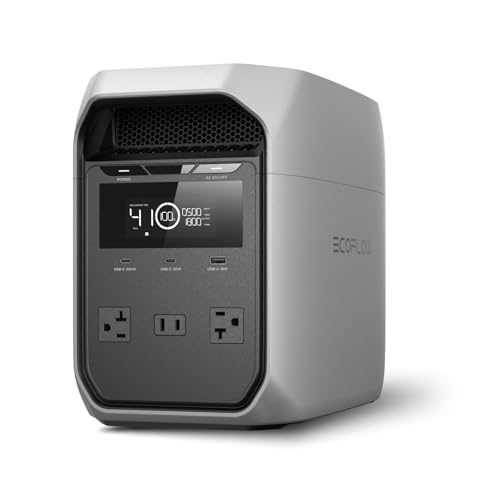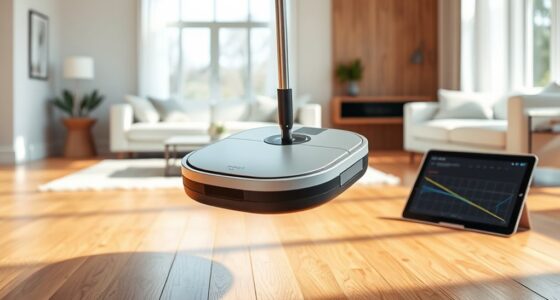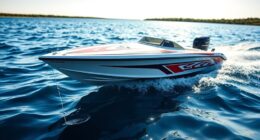If you’re looking for the best solar generators for home backup in 2025, I’ve found top models like the Jackery HomePower 3000, Anker SOLIX series, EcoFlow DELTA 2 Max, and others that combine high capacity, portability, and fast recharging. These options offer reliable power for emergencies, outdoor use, or everyday needs, with long-lasting durability and safety features. Keep exploring, and you’ll discover which one suits your specific backup power needs best.
Key Takeaways
- High-capacity solar generators like Jackery HomePower 3000 and OSCAL 3600Wh ensure reliable power for home backup during outages.
- Fast recharging options, including AC, solar, and car charging, minimize downtime and maintain continuous power supply.
- Portability features enable easy deployment for emergency use, outdoor activities, or off-grid living.
- Advanced safety and durability ensure long-term, safe operation in various environmental conditions.
- Versatile use cases cover household backup, outdoor adventures, RVing, and long-term off-grid power needs.
Jackery HomePower 3000 Portable Power Station with Solar Panels
If you’re looking for a reliable home backup solution, the Jackery HomePower 3000 Portable Power Station with Solar Panels is an excellent choice, especially for those who want a compact yet powerful device. It boasts a 3600W surge capacity and a 3072Wh LiFePO4 battery, capable of powering essentials like fridges, lights, and medical devices for hours. Weighing just under 60 pounds, it’s 47% smaller and 43% lighter than similar models, making it portable and easy to handle. With versatile ports and fast charging options, including solar panels, it guarantees you stay powered during outages or outdoor adventures, offering peace of mind and convenience.
Best For: homeowners, RV travelers, and emergency preparedness enthusiasts seeking a reliable, portable, and versatile backup power solution.
Pros:
- High capacity with 3600W surge and 3072Wh LiFePO4 battery for extended power supply
- Compact and lightweight design, 47% smaller and 43% lighter than comparable models for easy portability
- Multiple fast-charging options including solar panels, AC, and car charger, with versatile ports
Cons:
- Weighs around 59.5 pounds, which may be heavy for some users to carry frequently
- Higher upfront cost compared to smaller or less powerful portable power stations
- Limited availability of the product and accessories in certain regions
Anker SOLIX C1000 Portable Power Station
The Anker SOLIX C1000 Portable Power Station stands out as an excellent choice for homeowners seeking reliable backup power during outages, thanks to its robust 1056Wh LiFePO4 battery and rapid recharging capabilities. It delivers 1800W continuous power with a peak of 2400W, powering most appliances easily. Recharging is fast—80% in just 43 minutes with UltraFast tech or full in under an hour via AC. It also supports eco-friendly outdoor use, recharging in 1.8 hours with solar power. Its durable design, versatile ports, and smart app features make it a dependable, long-lasting power solution for home backup, camping, or RV adventures.
Best For: homeowners seeking a reliable, long-lasting backup power solution for outages, outdoor camping, or RV use with fast recharging and versatile power options.
Pros:
- High capacity (1056Wh) with a 10-year lifespan due to LiFePO4 battery technology
- Rapid recharging: 80% in 43 minutes and full in under an hour via AC or 1.8 hours with solar power
- Versatile output with 11 ports and Peak SurgePad technology supporting most appliances
Cons:
- Slightly heavier and larger than smaller portable power stations, which may affect portability for some users
- Higher initial cost compared to basic portable batteries or generators
- Requires solar panel or AC source for recharging, limiting use in completely off-grid scenarios without accessories
Anker SOLIX F2000 Portable Power Station
For those seeking a reliable backup power source at home or during outdoor adventures, the Anker SOLIX F2000 Portable Power Station stands out with its impressive 2400W continuous output and massive 2048Wh capacity. Weighing just 67.3 pounds, it offers multiple outlets, including AC, USB-C, USB-A, car, and even an RV port, supporting devices up to 3600W with SurgePad technology. Its GaNPrime battery guarantees efficient power conversion and a 10-year lifespan thanks to InfiniPower technology. Rapidly recharged in just 1.4 hours via HyperFlash, it’s perfect for camping, RV use, or home backup, backed by a 5-year warranty and customer support.
Best For: outdoor enthusiasts, homeowners seeking reliable backup power, and RV travelers needing portable energy solutions.
Pros:
- High capacity with 2048Wh and 2400W continuous output for versatile power needs.
- Multiple outlets including AC, USB-C, USB-A, car, and RV port for broad device compatibility.
- Rapid recharge capability, going from 0 to 80% in just 1.4 hours with HyperFlash technology.
Cons:
- Heavier at 67.3 pounds, which may affect portability for some users.
- Higher price point compared to smaller or less feature-rich portable power stations.
- Limited to a 5-year warranty, which may be shorter than some users expect for long-term durability.
Anker SOLIX C1000 Gen 2 Portable Power Station
With its powerful 1,024Wh LiFePO4 battery and 2,000W continuous output, the Anker SOLIX C1000 Gen 2 Portable Power Station is an excellent choice for homeowners looking to keep essential devices running during outages. It supports up to 10 devices simultaneously, making it versatile for home backup, emergencies, or outdoor adventures. Its compact, lightweight design—14% smaller and 11% lighter than similar models—ensures easy portability and storage. Recharging is lightning-fast with HyperFlash technology, taking just 49 minutes, or 1.8 hours via solar. With weatherproof solar panels and a durable build, this station is built to last over a decade of daily use.
Best For: homeowners, campers, and outdoor enthusiasts seeking reliable, fast-charging portable power for emergency backup, off-grid use, or outdoor activities.
Pros:
- Rapid recharge time of just 49 minutes with HyperFlash technology.
- Supports up to 10 devices simultaneously, ideal for home or outdoor use.
- Durable, weatherproof solar panels and long-lasting battery with over 4,000 cycles.
Cons:
- May be heavier and bulkier compared to smaller portable power options.
- Higher initial cost due to advanced features and large capacity.
- Requires specific cables for charging, which might need to be purchased separately in some cases.
EF ECOFLOW Portable Power Station DELTA 2 Max
Looking for a reliable backup power source that can handle your entire household during outages? The EF ECOFLOW DELTA 2 Max is a portable solar generator with a 2400W continuous output and a 2048Wh capacity, making it perfect for home backup. Its durable 10-year LFP battery offers up to 3,000 cycles, ensuring long-term reliability. It charges rapidly—80% in just 43 minutes with solar and AC combined—and can expand from 2kWh to 6kWh with additional batteries. With 15 outlets, quiet operation, and remote management via the EcoFlow app, it’s a versatile, efficient, and user-friendly power solution.
Best For: households seeking a reliable, portable backup power solution capable of running most home appliances during outages.
Pros:
- Fast charging capability: 80% in just 43 minutes with solar and AC combined
- Durable 10-year LFP battery with up to 3,000 cycles for long-term use
- Quiet operation at 30 dB, suitable for overnight or noise-sensitive environments
Cons:
- Heavier weight of 50.6 pounds may be less portable for some users
- Limited to a maximum output of 3400W with X-Boost mode, which may not support very high-wattage devices
- Higher upfront cost compared to traditional gas generators
Jackery Explorer 2000 v2 Portable Power Station
The Jackery Explorer 2000 v2 Portable Power Station stands out as an ideal choice for homeowners seeking reliable backup power during outages, thanks to its massive 2042Wh LiFePO4 battery and 2200W AC output. It offers three AC ports, fast USB-C PD charging, and a lightweight design at just 39.5 pounds, making it portable and easy to handle. With fast AC charging, solar options, and whisper-quiet operation, it’s perfect for indoor and outdoor use. Its advanced safety features, UL1778 certification, and seamless UPS switching ensure dependable, long-term backup power during emergencies, making it a versatile and reliable addition to your home power system.
Best For: homeowners, outdoor enthusiasts, and small businesses seeking reliable, portable backup power during outages and outdoor activities.
Pros:
- High-capacity 2042Wh LiFePO4 battery provides long-lasting power for various needs.
- Lightweight and compact design (39.5 lbs), making it portable and easy to handle.
- Fast charging options including AC fast charge, solar, and silent modes with minimal noise.
Cons:
- Price may be higher compared to smaller or less advanced portable power stations.
- Limited to 2200W AC output, which might not cover all high-power appliances.
- Requires compatible solar panels for optimal solar charging performance.
BROWEY 1600W Portable Power Station with Solar Panel and 1024Wh Battery
If you’re seeking a reliable backup power source that combines portability with high performance, the BROWEY 1600W Portable Power Station is an excellent choice. It features a 1024Wh LiFePO4 battery with a 1600W continuous output, peaking at 3200W, capable of running refrigerators, CPAP machines, and tools. Recognized with the iF Design Award 2022, it’s built for outdoor adventures and emergencies. The station includes multiple ports—AC, DC, and USB-C—and supports solar charging with an MPPT controller. Its long-lasting battery, safety features, and versatile charging options make it a dependable power solution for home backup and off-grid living.
Best For: outdoor enthusiasts, emergency preparedness, and off-grid living who need reliable, portable power to run essential devices and appliances.
Pros:
- High-capacity 1024Wh LiFePO4 battery with over 3000 cycles for long-term use
- 1600W continuous power output with 3200W peak, suitable for various appliances and tools
- Multiple charging options including solar, AC, and car outlet for versatile power sourcing
Cons:
- Slightly heavy and bulky for ultra-portable use on long hikes or extreme portability needs
- Limited to 80% charging in about 3 hours via AC and USB-C simultaneously, which may be slower than some competitors
- Higher initial cost compared to smaller or less feature-rich portable power stations
Jackery Solar Generator 300, 293Wh Backup Lithium Battery with Solar Panel
For those seeking a reliable and portable power source during power outages or outdoor activities, the Jackery Solar Generator 300 stands out. Weighing only 7.1 pounds, it features a 293Wh lithium-ion battery paired with the SolarSaga 100W solar panel, making it easy to recharge via solar or wall outlet in just a few hours. It offers two pure sine wave AC outlets, a fast-charging USB-C port, and multiple outputs to power devices like laptops, cameras, and drones simultaneously. Safe, quiet, and maintenance-free, this generator is perfect for camping, emergency backup, or road trips. Its compact design and 2-year warranty add to its appeal as a versatile, eco-friendly power solution.
Best For: outdoor enthusiasts, campers, and emergency preparedness individuals seeking a reliable, portable, and eco-friendly power source for off-grid or backup power needs.
Pros:
- Lightweight and portable at only 7.1 pounds, making it easy to carry on outdoor adventures.
- Fast recharge options via wall outlet or solar panel, with up to 80% in 2 hours.
- Multiple output ports including AC, USB-C, USB-A, and car outlet, supporting various devices simultaneously.
Cons:
- Limited continuous power output of 300W, which may not support high-wattage appliances.
- Solar panel shipped separately, requiring additional purchase for solar recharging.
- Battery capacity of 293Wh may be insufficient for extended power needs during prolonged outages or remote use.
OSCAL PowerMax 6000 Solar Generator
Looking for a reliable home backup solution that can handle your essential appliances during outages? The OSCAL PowerMax 6000 offers a massive 3600Wh LiFePO4 battery, supporting up to 3500 cycles and lasting up to 25 years. With 6000W continuous AC power (surge 7200W), it powers multiple devices simultaneously, including heavy appliances. It charges quickly—full recharge in just 1.44 hours using AC or solar. Its EPS system guarantees seamless switching during outages, while the smartphone app allows remote control and monitoring. Comes with three solar panels, making outdoor use easy. Designed for durability and safety, it’s perfect for dependable home backup.
Best For: households and outdoor enthusiasts seeking a reliable, high-capacity backup power solution for essential appliances and equipment during outages or outdoor activities.
Pros:
- High-capacity 3600Wh LiFePO4 battery supports up to 3500 cycles, ensuring long-term reliability.
- Powerful 6000W continuous AC output with surge capability of 7200W, suitable for heavy appliances.
- Fast recharging in just 1.44 hours via AC or solar power, enabling quick turnaround during emergencies.
Cons:
- The unit’s size and weight may require significant space and effort to move or install.
- Initial investment can be high compared to smaller or less capable backup solutions.
- Limited to three solar panels included, which may require additional panels for faster solar charging in some scenarios.
EF ECOFLOW Portable Power Station DELTA 3 Classic, 1024Wh LiFePO4 Battery
The EF ECOFLOW Portable Power Station DELTA 3 Classic stands out as an ideal choice for homeowners seeking reliable backup power during outages or emergencies. With a 1024Wh LiFePO4 battery, it offers 1800W continuous power, expandable to 2600W with X-Boost technology, supporting appliances like refrigerators, microwaves, and laptops. It features 15 versatile outlets, including AC and USB-C ports, for flexible device connections. Charging is quick—reaching 80% in just 45 minutes via X-Stream technology—and solar recharging takes only 2.5 hours with a 500W panel. Its smart management system ensures safety, durability, and remote control, making it a dependable, portable power solution.
Best For: homeowners, outdoor enthusiasts, and emergency preparedness users seeking reliable, versatile portable power with fast recharge capabilities.
Pros:
- High capacity of 1024Wh and 1800W continuous power, supporting a wide range of appliances
- Rapid AC charging from 0% to 80% in 45 minutes with X-Stream technology
- Smart management system with remote control via EcoFlow app enhances convenience and safety
Cons:
- Relatively heavy at 26.7 pounds, which may affect portability for some users
- Limited to solar recharge in 2.5 hours with a 500W panel, requiring additional equipment for optimal solar use
- Slightly higher price point compared to smaller or less feature-rich portable power stations
Jackery HomePower 3600 Plus Portable Power Station
If you need a reliable backup power source capable of supporting essential household appliances during outages, the Jackery HomePower 3600 Plus Portable Power Station is an excellent choice. It delivers 3,600W AC output, expandable to 7,200W in parallel, with a 3,584Wh LFP battery that can grow up to 21kWh per unit or 43kWh with multiple units. Designed for home backup and outdoor use, it powers essentials like pumps, heaters, and dryers for over two weeks for a small household. Its durable, heat-resistant battery guarantees safety and longevity, while multiple charging options—including solar—offer flexibility. Its lightweight, portable design makes setup and movement effortless.
Best For: homeowners and outdoor enthusiasts seeking a reliable, portable backup power solution for essential appliances and outdoor activities.
Pros:
- High power output of 3600W (7200W in parallel) suitable for running multiple household appliances simultaneously
- Expandable capacity up to 43kWh with multiple units, providing long-term energy security
- Durable, heat-resistant battery with a lifespan of 10 years and 6,000 charge cycles
Cons:
- Hefty weight of approximately 77.2 pounds may require assistance for transport
- Relatively high upfront cost compared to smaller portable power stations
- Limited to 4-hour solar charging time, which may be insufficient for continuous renewable energy input
Portable Power Station 300W (GRECELL 230.88Wh Solar Generator)
The GRECELL 230.88Wh Solar Generator is an ideal choice for anyone seeking reliable, portable backup power during outages or outdoor adventures. With a 230.88Wh capacity and a 330W continuous output, it can power laptops, phones, lights, fans, and small appliances like mini-refrigerators and TVs. Its compact, lightweight design makes it perfect for camping, travel, or emergency use. Equipped with an upgraded lithium battery, advanced BMS, and dual cooling fans, it ensures safety and longevity. Multiple charging options—including USB-C PD, AC, and solar—maximize versatility, while the built-in MPPT controller optimizes solar energy from the 40W panel for efficient recharging.
Best For: outdoor enthusiasts, campers, and emergency preparedness individuals seeking reliable portable power for multiple devices.
Pros:
- Compact and lightweight design for easy portability and travel.
- Multiple charging options including USB-C PD, AC, and solar, offering versatile recharging.
- Advanced safety features with BMS and dual cooling fans to ensure long-term durability.
Cons:
- Limited capacity of 230.88Wh may not support high-power appliances for extended periods.
- Solar panel included is only 40W, which may result in longer recharging times under cloudy conditions.
- Continuous power output of 330W might not be sufficient for larger appliances or high-demand electronics.
EF ECOFLOW Portable Power Station (DELTA Pro)
For homeowners seeking reliable, high-capacity backup power, the EF ECOFLOW Portable Power Station (DELTA Pro) stands out with its impressive 3600Wh LiFePO4 battery. It supports home backup, outdoor adventures, and emergencies, with expandable capacity up to 25kWh using additional batteries or smart generators. Featuring 15 output ports—including AC, USB-C, USB-A, DC, and car outlets—it can power multiple devices simultaneously. With a maximum output of 4500W via X-Boost and 7200W when paired, it handles heavy-duty appliances. Fast charging via X-Stream technology recharges in under two hours, and remote monitoring via the EcoFlow app makes managing power easy and efficient.
Best For: homeowners, outdoor enthusiasts, and emergency preparedness users seeking reliable, high-capacity portable power with fast charging and versatile device compatibility.
Pros:
- Large 3600Wh LiFePO4 battery capacity with expandable options up to 25kWh for versatile power needs
- Multiple output ports including AC, USB-C, USB-A, DC, and car outlets for simultaneous device charging
- Rapid X-Stream charging technology recharges in under two hours, ensuring minimal downtime
Cons:
- Heavyweight at 99 pounds, which may be less portable for some users
- Higher initial cost compared to smaller or less feature-rich portable power stations
- Size may require ample storage space and secure handling during transport
OUKITEL P2001 PLUS Portable Power Station (2048Wh)
With a massive 2048Wh capacity and 2400W rated power, the OUKITEL P2001 PLUS Portable Power Station stands out as the ideal choice for homeowners seeking reliable backup power during outages. It features 13 outlets—including AC, USB-C, USB-A, DC, and a cigar lighter—allowing you to power multiple devices simultaneously. Its LiFePO4 battery offers 15 years of lifespan and over 3500 charge cycles, ensuring durability. Supports fast charging via AC or solar, with a combined input up to 2300W. Weighing 47.5 pounds, it’s portable enough for home use, camping, or off-grid scenarios, providing peace of mind during emergencies.
Best For: homeowners, campers, and off-grid enthusiasts seeking reliable, long-lasting backup power with multiple device compatibility.
Pros:
- Large 2048Wh capacity and 2400W power support multiple appliances simultaneously.
- Long-lasting LiFePO4 battery with a 15-year lifespan and over 3500 charge cycles.
- Supports fast charging via AC and solar inputs, reaching 80% in just 50 minutes.
Cons:
- Heavy at 47.5 pounds, which may affect portability for some users.
- Premium price point due to high capacity and advanced features.
- Limited to a maximum solar and AC input of 2300W, which may be insufficient for very high-demand devices.
Portable Solar Generator, 300W Power Station with 60W Foldable Solar Panel, 110V Lithium Battery Pack
If you’re looking for a reliable backup power solution that’s easy to transport and set up, the ZeroKor 300W Portable Solar Generator is an excellent choice. It features a 280Wh lithium-ion battery capable of charging phones, laptops, and small devices. The included 60W foldable solar panel supports multiple recharging methods, including solar, wall outlet, and carport. With multiple outlets—AC, USB, and DC—you can power several devices simultaneously. Built-in safety features like a Battery Management System guarantee safe operation. Perfect for camping, RV trips, or emergency backup, it provides versatile, clean power wherever you need it most.
Best For: outdoor enthusiasts, campers, and emergency preparedness individuals seeking a portable, versatile power source for small devices and off-grid use.
Pros:
- Compact and lightweight design for easy transport and setup
- Multiple charging options including solar, AC, and carport for versatile recharging
- Built-in safety features like BMS ensure reliable and safe operation
Cons:
- Limited to 300W capacity, unsuitable for high-power appliances
- Solar panel junction box is not waterproof, requiring caution outdoors
- Not ideal for continuous high-load or long-duration power needs
Factors to Consider When Choosing a Solar Generator for Home Backup

When selecting a solar generator for home backup, I consider factors like power capacity to meet my needs and how fast it recharges during outages. I also look at port options to connect my essential devices and check the battery’s lifespan for long-term reliability. Finally, I keep portability in mind so I can easily move or store it when not in use.
Power Capacity Needs
Choosing the right solar generator for home backup hinges on understanding your power capacity needs. First, add up the wattage of essential devices you want to run during an outage, ensuring the generator can handle this load. Remember, appliances with motors or compressors, like refrigerators, often require surge power two to three times their standard wattage temporarily. Match the generator’s continuous wattage output to your total running wattage for reliable operation. It’s wise to contemplate future needs or possible expansion by selecting a generator with a higher capacity than your current estimate. Additionally, check the battery capacity measured in watt-hours (Wh) or amp-hours (Ah) to ensure it provides enough backup time during extended outages. Proper sizing guarantees consistent power without overloading or running out of juice.
Recharging Speed
Recharging speed is a essential factor because it determines how quickly your solar generator can be ready for use after a power outage or during off-grid situations. Some models can reach 80% or full capacity in under 2 hours, thanks to high-wattage AC inputs of 1800W or more, enabling rapid power restoration. Hybrid charging options, combining solar panels with AC power, can considerably cut recharging times, especially with solar inputs of 1000W or higher. Technologies like HyperFlash or X-Stream further boost recharge speeds, often under an hour, which is indispensable during emergencies. Keep in mind, larger batteries take longer to recharge unless supported by high-output inputs. Prioritizing fast recharging ensures your generator minimizes downtime and maximizes reliability when you need it most.
Port Selection Options
Selecting the right port options is essential because they determine how many devices you can power simultaneously and how well the generator fits your household needs. A versatile solar generator should have multiple outlet types, including AC, USB-C, USB-A, DC, and RV ports, to support various appliances and gadgets. The number and configuration of ports affect your ability to run multiple devices during an outage. Fast-charging protocols like Power Delivery (PD) and Quick Charge improve efficiency and reduce recharging time. Dedicated high-wattage ports, such as 100W or more, allow you to power larger appliances or outdoor equipment. A well-designed unit offers flexible options, ensuring compatibility with household electronics and outdoor gear, making your backup power setup more versatile and reliable.
Battery Longevity
Battery longevity is a critical factor to think about because it directly impacts how long your solar generator will reliably power your home during outages. The lifespan mainly depends on the battery’s cycle count—more cycles mean a longer-lasting battery. Lithium Iron Phosphate (LiFePO4) batteries stand out, offering 3,000 to 4,000 charge cycles, which can translate to about 10 years of daily use. Batteries equipped with advanced Battery Management Systems (BMS) help prevent overcharging, overheating, and deep discharges, extending their life. Regular maintenance and shallow discharges also contribute to longevity. When choosing a solar generator, it’s important to weigh the rated cycle life and how well the battery maintains capacity over time. These factors ensure your backup power remains dependable for years to come.
Portability and Size
When choosing a solar generator for home backup, considering its portability and size is key to ensuring it fits your needs and lifestyle. A compact, lightweight unit is easier to transport and store during emergencies or outdoor adventures. The dimensions and weight directly affect portability, with smaller models usually weighing under 50 pounds for easier handling. Features like foldable or integrated handles can make carrying and maneuvering much simpler, especially in tight spaces. Wheels or telescopic handles are also helpful for moving the generator across different terrains or between locations. However, it’s important to balance portability with capacity—make sure the generator isn’t too bulky to carry but still provides enough power for your essential devices.
Safety Features
Safety features are essential considerations because they guarantee your solar generator operates reliably without risking damage to your home or devices. I look for models with built-in Battery Management Systems (BMS) that protect against overcharging, over-discharging, short circuits, and overheating. These systems ensure safe operation and prolong the generator’s lifespan. I also check for UL or equivalent safety certifications, which verify compliance with established safety standards. To protect sensitive electronics, I prefer generators with pure sine wave output, reducing electrical noise and preventing damage. Thermal protection features, like temperature sensors and automatic shutdowns, are critical for preventing overheating during extended use. Lastly, I verify the presence of overload protection, short-circuit safeguards, and automatic circuit breakers for all-encompassing safety coverage.
Cost and Incentives
Are you aware of how much your total investment in a solar generator can be reduced through various incentives? Federal tax credits can cover up to 30% of installation costs, making the upfront expense more manageable. Many utility companies also offer rebates and incentives that can lower your initial investment further. The cost of a solar generator depends on capacity, features, and brand, with larger units typically costing more. However, choosing a model with a longer lifespan and more charge cycles can boost your long-term savings. Additionally, some regions have specific programs or tax benefits that make purchasing a solar generator even more affordable. Understanding these incentives helps you maximize your value and ensure you select a system that offers both reliability and financial efficiency.
Frequently Asked Questions
How Long Does a Typical Solar Generator Battery Last Before Needing Replacement?
A typical solar generator battery lasts about 5 to 15 years before needing replacement, depending on usage and maintenance. I’ve found that batteries with higher quality and proper care tend to last longer. Regularly monitoring the battery’s health, avoiding deep discharges, and keeping it within recommended temperature ranges can extend its lifespan. When it finally needs replacing, it’s usually a sign that it’s time for an upgrade.
Can Solar Generators Operate During Extreme Weather Conditions?
Solar generators can often operate during some extreme weather conditions, but their performance depends on the severity. I recommend checking the manufacturer’s guidelines because heavy rain, snow, or high winds can impact their efficiency and safety. Usually, they’re designed to withstand typical weather, but extreme storms might require unplugging or relocating them to a safer spot. Always prioritize safety and proper maintenance to guarantee reliable power when you need it most.
Are There Any Safety Concerns Using Solar Generators Indoors?
Using solar generators indoors is generally safe, but you should take some precautions. I always guarantee proper ventilation because they can produce heat or small amounts of exhaust, especially if they have internal fans. Avoid placing them near flammable materials and keep them dry. I also recommend following the manufacturer’s instructions carefully to prevent any electrical issues. When used properly, solar generators are a safe and reliable backup power source indoors.
How Scalable Are These Solar Generators for Whole-Home Backup?
Think of these solar generators as the roots of a mighty tree—they can grow and extend to support your entire home. They’re quite scalable, especially when paired with additional panels or larger capacity units. While some might need a bit of planning, I’ve found that with the right setup, you can expand your backup power smoothly, making your home resilient during outages. It’s all about building a solid foundation for reliable energy.
What Maintenance Is Required to Keep Solar Generators Functioning Optimally?
To keep my solar generator running smoothly, I regularly check the connections and clean the solar panels to maximize efficiency. I also monitor the battery levels and make certain they’re not overcharged or deeply discharged. Occasionally, I update the firmware if needed and store the unit in a cool, dry place when not in use. Simple maintenance like this helps my generator stay reliable whenever I need backup power.
Conclusion
Choosing the right solar generator can feel overwhelming, but remember, the perfect backup power isn’t just a small comfort—it’s your lifeline when everything else falls silent. With the top options I’ve shared, you’re not just investing in a device; you’re securing peace of mind that’s stronger than a fortress. So, pick wisely and prepare to face any blackout like a hero—because reliable power is truly a game-changer in today’s world.























